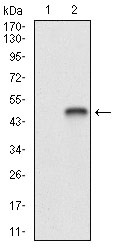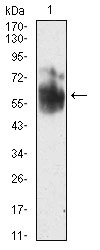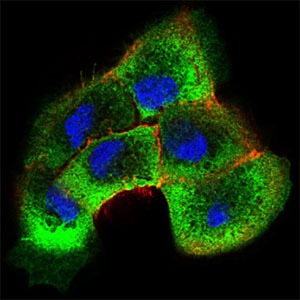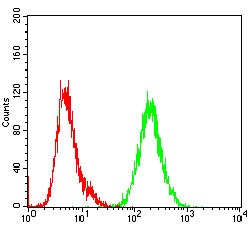Shopping Cart
- Remove All
 Your shopping cart is currently empty
Your shopping cart is currently empty
Anti-Shc Antibody (2E265) is a Mouse antibody targeting Shc. Anti-Shc Antibody (2E265) can be used in FCM,ICC,WB.
| Pack Size | Price | Availability | Quantity |
|---|---|---|---|
| 50 μL | $297 | 7-10 days | |
| 100 μL | $427 | 7-10 days |
| Description | Anti-Shc Antibody (2E265) is a Mouse antibody targeting Shc. Anti-Shc Antibody (2E265) can be used in FCM,ICC,WB. |
| Synonyms | Src homology 2 domain-containing-transforming protein C1, SHC-transforming protein A, SHC-transforming protein 3, SHC-transforming protein 1, SHCA, SHC1_HUMAN, SHC1, SHC transforming protein 1, SHC transforming protein, SHC adaptor protein 1, SHC A, SHC 1, SHC (Src homology 2 domain containing) transforming protein 1, Shc, SH2 domain protein C1, p66SHC, p66, FLJ26504 |
| Clone | 2E265 |
| Reactivity | Human,Mouse |
| Verified Activity | 1. Western blot analysis of SHC1 on human SHC1 recombinant protein using anti-SHC1 antibody at 1/1,000 dilution. 2. Western blot analysis of SHC1 on HEK293 (1) and SHC1-hIgGFc transfected HEK293 (2) cell lysate using anti-SHC1 antibody at 1/1,000 dilution. 3. Western blot analysis of SHC1 on NIH/3T3?cell lysate using anti-SHC1 antibody at 1/1,000 dilution. 4. ICC staining SHC1 (green) and Actin filaments (red) in A431 cells. The nuclear counter stain is DAPI (blue). Cells were fixed in paraformaldehyde, permeabilised with 0.25% Triton X100/PBS. 5. Flow cytometric analysis of NIH/3T3 cells with SHC1 antibody at 1/100 dilution (green) compared with an unlabelled control (cells without incubation with primary antibody; red).      |
| Application | |
| Recommended Dose | WB: 1:500-2000; IHC: 1:50-200; ICC: 1:50-200; FCM: 1:50-100 |
| Antibody Type | Monoclonal |
| Host Species | Mouse |
| Construction | Hybridoma Monoclonal Antibody |
| Purification | ProA affinity purified |
| Appearance | Liquid |
| Formulation | 1*TBS (pH7.4), 1%BSA, 40%Glycerol. Preservative: 0.05% Sodium Azide. |
| Research Background | Growth factor triggering of protein tyrosine kinase receptors induces signals that cascade to the nucleus activating mitogenic, as well as other, responses. Critical components of this process include adapter proteins such as Shc and IRS-1 that lack detectable catalytic activity. These are immediate substrates of receptor tyrosine kinase activity and serve to physically link activated receptors to downstream signaling components. Whereas Shc has been implicated in signaling by diverse receptor families, IRS-1 serves primarily as the major insulin receptor substrate (4-7). Shc also participates in insulin signaling by linking the insulin receptor to Ras by forming complexes with the adapter protein GRB2 and Sos independently of IRS-1. A protein immunologically related to IRS-1, originally designated 4PS and now known as IRS-2, was shown to become highly tyrosine phosphorylated in response to IL-4 or IGF-1 in cells lacking IRS-1. An additional member of this family of signaling intermediates, Shb, is a SH2-containing protein with characteristic proline-rich domains. |
| Conjucates | Unconjugated |
| Immunogen | Recombinant Protein |
| Uniprot ID |
| Molecular Weight | Theoretical: 63 kDa. |
| Stability & Storage | Store at -20°C or -80°C for 12 months. Avoid repeated freeze-thaw cycles. |
| Transport | Shipping with blue ice. |

Copyright © 2015-2025 TargetMol Chemicals Inc. All Rights Reserved.